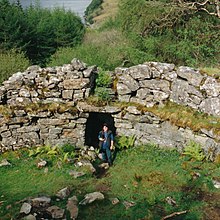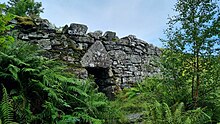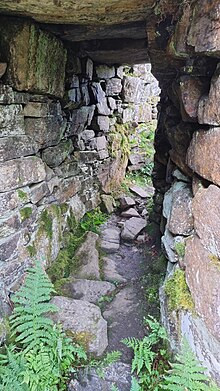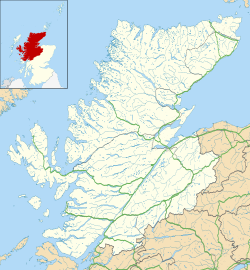 Interior of Caisteal Grugaig | |
| Location | Scottish Highlands |
|---|---|
| Coordinates | 57°15′59″N 5°32′21″W / 57.26649°N 5.539271°W |
| Type | Broch |
| History | |
| Periods | Iron Age |
Caisteal Grugaig (or Dun Totaig) is an Iron Age broch near the eastern end of Loch Alsh in the Scottish Highlands ( grid reference NG86682508).
Location
The broch is located in the district of Lochalsh, and is about 9 kilometres northwest of Shiel Bridge. [1] It stands on a small rocky knoll on a grassy slope. [2]
The "Glenelg Brochs" of Dun Telve and Dun Troddan are a few miles to the south. [2] Caisteal Grugaig should not be confused with the "semi-broch" known as Dun Grugaig which is also near Glenelg. [3]
Description
The broch has an external diameter of around 16.5 metres and an internal diameter of around 9.6 metres. [2] The broch was built on uneven ground, so the natural floor of the broch has a slope. [2] The entrance passage is on the northeast side and has a massive triangular lintel over the doorway. [1] There is an elongated guard cell on the left side of the entrance passage. [2]


The interior of the broch has two intramural rooms at ground level, one of which is a small, oval cell. [2] The other is a long mural cell, or length of ground gallery, which has a blocked doorway. [2] The sides of an upper room are apparent above the entrance passage. [2] Also inside the broch is a doorway to the mural stair. The five steps of the stair lead up to a long landing which leads to the beginning of a second flight of stairs. [2]
Excavations
The broch was cleared out in 1889 and no detailed record of the excavation seems to have survived. [2] Another attempt at excavation was conducted in 1924 with minimal results. [2] In the National Museum of Scotland is a decorated steatite cup apparently from this site. [2]
Notes
- ^ a b Ritchie, J N G (1998). Brochs of Scotland. Shire Publications. p. 45. ISBN 0747803897.
- ^ a b c d e f g h i j k l Historic Environment Scotland. "Caisteal Grugaig (11812)". Canmore. Retrieved 17 September 2014.
- ^ Historic Environment Scotland. "Dun Grugaig, Glenelg (11772)". Canmore. Retrieved 17 September 2014.
External links
![]() Media related to
Caisteal Grugaig at Wikimedia Commons
Media related to
Caisteal Grugaig at Wikimedia Commons
 Interior of Caisteal Grugaig | |
| Location | Scottish Highlands |
|---|---|
| Coordinates | 57°15′59″N 5°32′21″W / 57.26649°N 5.539271°W |
| Type | Broch |
| History | |
| Periods | Iron Age |
Caisteal Grugaig (or Dun Totaig) is an Iron Age broch near the eastern end of Loch Alsh in the Scottish Highlands ( grid reference NG86682508).
Location
The broch is located in the district of Lochalsh, and is about 9 kilometres northwest of Shiel Bridge. [1] It stands on a small rocky knoll on a grassy slope. [2]
The "Glenelg Brochs" of Dun Telve and Dun Troddan are a few miles to the south. [2] Caisteal Grugaig should not be confused with the "semi-broch" known as Dun Grugaig which is also near Glenelg. [3]
Description
The broch has an external diameter of around 16.5 metres and an internal diameter of around 9.6 metres. [2] The broch was built on uneven ground, so the natural floor of the broch has a slope. [2] The entrance passage is on the northeast side and has a massive triangular lintel over the doorway. [1] There is an elongated guard cell on the left side of the entrance passage. [2]


The interior of the broch has two intramural rooms at ground level, one of which is a small, oval cell. [2] The other is a long mural cell, or length of ground gallery, which has a blocked doorway. [2] The sides of an upper room are apparent above the entrance passage. [2] Also inside the broch is a doorway to the mural stair. The five steps of the stair lead up to a long landing which leads to the beginning of a second flight of stairs. [2]
Excavations
The broch was cleared out in 1889 and no detailed record of the excavation seems to have survived. [2] Another attempt at excavation was conducted in 1924 with minimal results. [2] In the National Museum of Scotland is a decorated steatite cup apparently from this site. [2]
Notes
- ^ a b Ritchie, J N G (1998). Brochs of Scotland. Shire Publications. p. 45. ISBN 0747803897.
- ^ a b c d e f g h i j k l Historic Environment Scotland. "Caisteal Grugaig (11812)". Canmore. Retrieved 17 September 2014.
- ^ Historic Environment Scotland. "Dun Grugaig, Glenelg (11772)". Canmore. Retrieved 17 September 2014.
External links
![]() Media related to
Caisteal Grugaig at Wikimedia Commons
Media related to
Caisteal Grugaig at Wikimedia Commons
